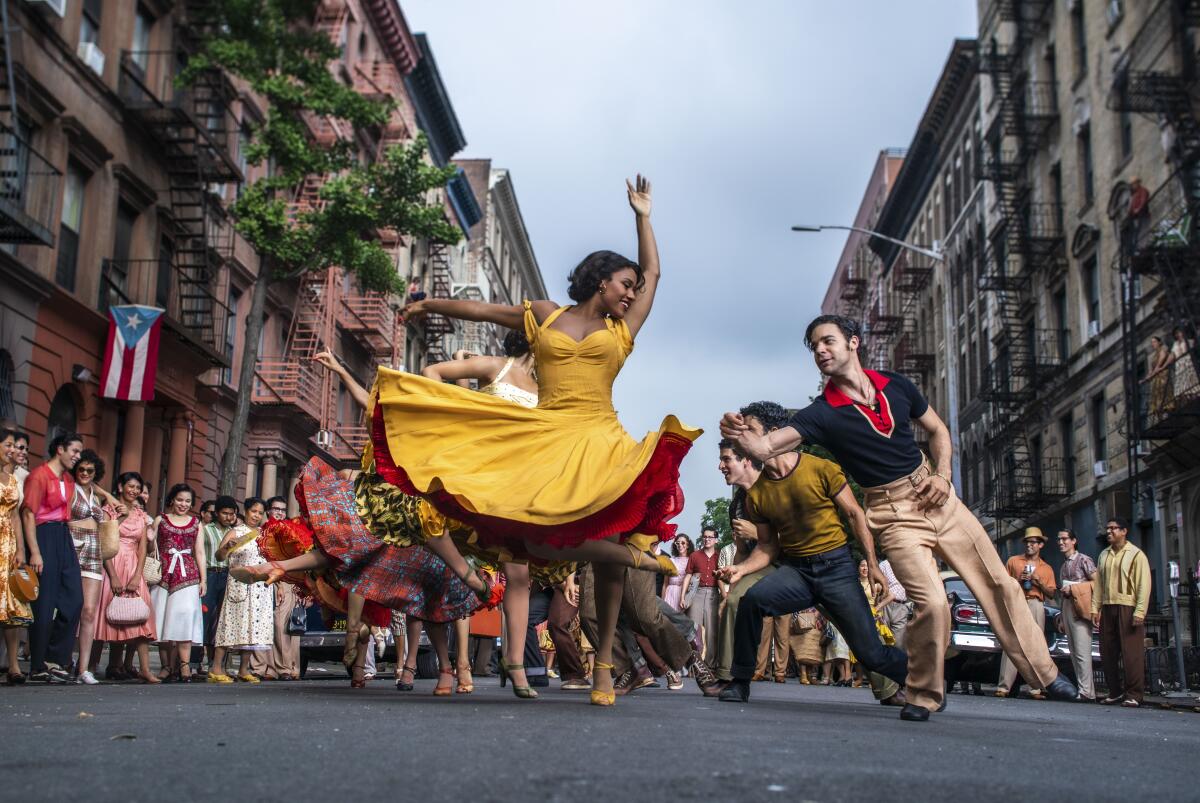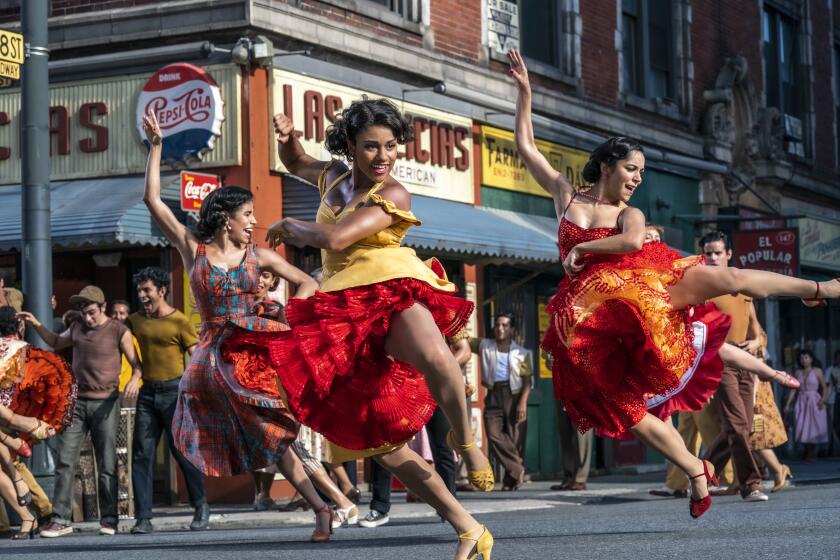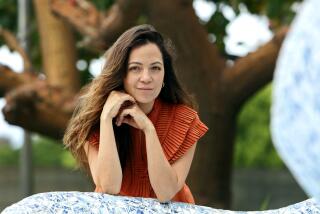Review: ‘West Side Story’ gets a unique and vital orchestral upgrade at the Hollywood Bowl

Ariana DeBose as Anita and David Alvarez as Bernardo in the 2021 movie version of “West Side Story.”
Steven Spielberg’s 2021 film version of “West Side Story” hasn’t won over everyone, but it did receive its fair share of critical raves and multiple nominations (if few actual wins) from all the institutions that get into the awards act. Were there an Oscar for best choreography on the screen, Justin Peck would have walked away with it in an instant.
The most common complaint about the movie was that there was simply no need for it, no matter how technically masterful Spielberg’s filmmaking is. It updated the beloved (and overrated) original 1961 “West Side Story” film without replacing it. Musically, the newer film is superior mainly in Gustavo Dudamel’s conducting and David Newman’s orchestral arrangement, which is truer to Bernstein’s Broadway score than the lavish one made, not by Bernstein, for the original film without the composer’s involvement. Still, it was hard to tell, what with over-aggressive sound engineering and the typically ghastly audio reproduction at most cinemas.
Shut your ears to the loud, screechy highs, to the overbearing vocal presence of so-so singers, to bass designed merely to show off subwoofers and to artificial surround sound effects meant to show off Dolby’s artificially intelligent Atmos, and maybe there’s an acceptable movie somewhere underneath.
On Tuesday night the Los Angeles Philharmonic began its Hollywood Bowl season, one celebrating the 100th anniversary of the orchestra’s concert inaugurating this venue. We like to think of the Bowl as being the soul of the L.A. summer, so why not use it to restore the soul of Spielberg’s “West Side Story”?
Dudamel and the L.A. Phil, which shares soundtrack duties with the New York Philharmonic, performed live to a screening. The movie came to life. It had a reason for being. But beware: This cinematic butterfly is short-lived. There is only one more performance, on Thursday.
Critics’ reactions, comparisons to the 1961 movie and more to know about the new “West Side Story” starring Ansel Elgort and Rachel Zegler.
The Bowl has been very good to “West Side Story.” Bernstein conducted the L.A. Phil in an incomparably rapturous performance of the “West Side Story: Symphonic Dances” in 1982 and recorded it that summer with the orchestra. Incomparable, that is, until 2007, when Michael Tilson Thomas matched his mentor on the rapture scale in a deeply probing performance of music seldom probed.
Four years later, the Bowl celebrated the 50th anniversary of the 1961 film by screening it with the orchestral score played live and conducted by Newman. That proved such an engrossing success that it has gone on to be done dozens of times around the world. Six years ago, Dudamel conducted a concert performance at the Bowl of the full “West Side Story” with an exciting, young Broadway cast in a performance that made the legendary Broadway show feel startlingly fresh.
From my seat on Tuesday, I had the view of 11, count ’em, screens. A big one over the stage, which was of little use the first hour before there was full darkness outdoors (a bright full moon also kept the amphitheater company). Two smaller video screens on either side of the stage are bright enough to be seen in daylight. Then there were the small screens in front of the pool section boxes; the supposedly best seats in the house have no view of the big screen. The large orchestra, which included a jazz ensemble, was dimly but visibly illuminated with blue light.
“West Side Story in Concert,” as the evening was advertised, meant just that: live performance, not moviegoing.
In the cinema, the best surround effect is at the very beginning. We hear the Jetsbefore seeing them, their whistles heard all around. It is a startlingly good way to draw in an audience and could not be duplicated at the Bowl, where the sound is stereo. But the great advantage of the Bowl‘s smaller soundstage is that your attention is focused on the orchestra.
At first, the Bowl amplification was closer to movie theater loud than ideal, but either one’s ears adapted (never a good thing) or the volume was toned down. The sound effects are what they are. The singers on the soundtrack, though, were not distorted, not amplified to the point where their every vocal weakness was exaggerated. I liked no singer in the theater, yet I disliked no singer at the Bowl. Rita Moreno’s “Somewhere,” so hard to take on the soundtrack, became moving here.
What mainly worked, though, was the sheer spirit and vitality Dudamel brought to the performance. His capacity to make the performance feel like the film was following him, not the other way around, was, in my experience, unique.
Of course, that is how the film was shot, since Dudamel conducted the soundtrack. But the effect was that Peck’s dances all but leapt off the screen. A weakness of the film is overly cautious singers, and that remains. But characters on the screen don’t dominate in this environment the way they do in the theater or on your home screen. They are part of a bigger picture. They leave room for a little imagination on the part of the viewer.
What did dominate was a scintillating orchestra, especially in the dance sequences, and the story sounded like it should. Yes, the outside world did find its way in. Wouldn’t you know it, during the rumble scene when the police arrive, a police helicopter just south of the Bowl could be heard circling what appeared to be a Hollywood crime scene. Everyone hates helicopters over the Bowl. This time it was chilling.
There will be one more performance Thursday. May I recommend it to the administrators of the Academy Museum of Motion Pictures and their music-and-dance-poor museum. They might learn something.
‘West Side Story in Concert’
Where: Hollywood Bowl, 2301 N. Highland Ave.
When: 8 p.m. Thursday
Tickets: $16-$136
Info: (323) 850-2000, hollywoodbowl.com
More to Read
The biggest entertainment stories
Get our big stories about Hollywood, film, television, music, arts, culture and more right in your inbox as soon as they publish.
You may occasionally receive promotional content from the Los Angeles Times.












